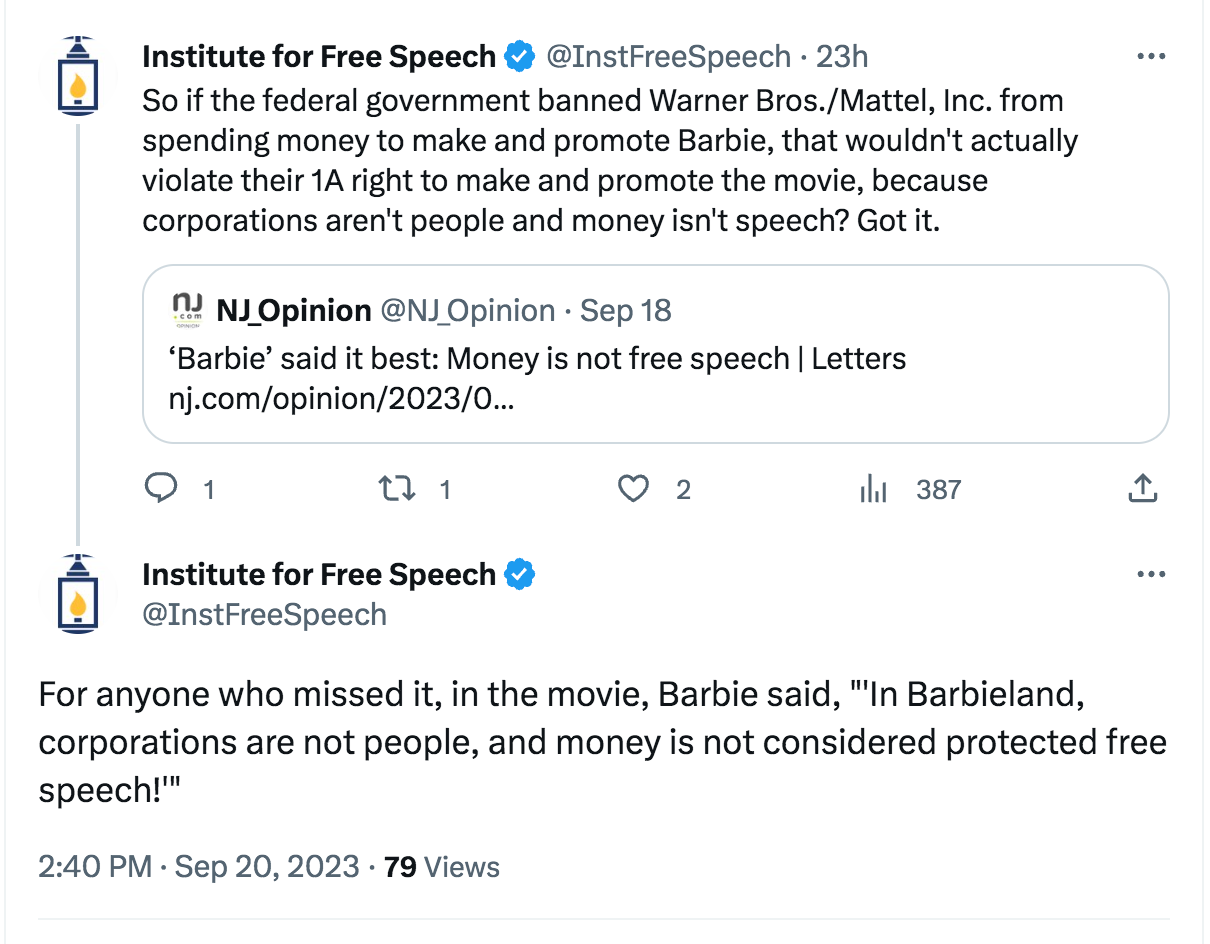E-Pluribus | September 21, 2023
Media can't agree on what news is fit to print; the shifting identity of "gender identity"; and racial polarization is headed... down?
A round-up of the latest and best writing and musings on the rise of illiberalism in the public discourse:
Matt Welch: Media Critics Agree: Stop Interviewing the Bad People!
There can be a fine line between reporting the news and giving free PR in a media environment where fortunes and status can be earned equally by good or bad press. But, as Matt Welch writes at Reason, many in the media allow their ideology to interfere with sound, disinterested news judgment despite their self-proclaimed pursuit of “truth.”
On Sunday, NBC's Meet the Press, which has been interviewing notable politicians for the past 75 years, brought in for questioning the runaway favorite for the 2024 GOP presidential nomination: Donald Trump.
Media critics were—predictably by now—livid. Not just at new MTP host Kristin Welker's inability to corral Washington's most slippery fish, but at the very notion that a politician-interviewing show should even interview this particular politician, after all that he has done.
[ . . . ]
"Interviewing Trump does not work," declared NYU journalism professor Jay Rosen. "No accountability moment ever comes." Welker's effort "proved once again that interviewing the 45th president is an impossible task," averred Vanity Fair's Molly Jong-Fast. The Bulwark's Jonathan Last made the bold comportmental assertion that the "media's job—and particularly broadcast media—is to think deeply about how to avoid helping Trump with its coverage….It would be nice if the folks in broadcast media could lend us—and democracy—a hand. Or, at the very least, stop giving aid and comfort to the authoritarian just because you want to pull a ratings number."
Such sentiments were rarely heard in the mainstream media 25 years ago. Back then one might sporadically encounter a Committee of Concerned Journalists member clucking about the need to hold firm on traditional, nonpartisan journalistic values of verification, particularly in the face of such debasing new ideologically tainted Web phenomena as The Drudge Report. It was mostly on the political margins—the Nation left, the Free Republic right—where you'd find critics chipping away at the unconscious or unacknowledged biases in the aspirationally neutral and still-potent MSM. Progressives would complain that the right had learned to successfully "work the refs"; conservatives would charge that newsrooms nursed a secret agenda to tip elections toward Democrats.
Now the agenda is no longer secret, and the ref-working is coming from inside the house.
Read the whole thing.
Lisa Selin Davis: The Problems With ‘Gender Identity’
At Colin Wright’s Substack, Reality’s Last Stand, author Lisa Selin Davis delves into the history of the term gender identity. Davis says that language in the gender debate has been so corrupted that it’s barely useful in medical or scientific contexts and is more often simply used as a political or cultural battering ram to advance a transgender social agenda.
There’s plenty of debate about who used the term gender identity first and what they meant; [Alex Byrne, a professor of philosophy at MIT] and others have been digging and debating and adding to the vault of knowledge in recent publications. [UCLA psychiatrist Robert Stoller] asserted that he and Greenson coined the term after much discussion, though it had been used—if not clearly defined—by sexologists and psychologists like John Money and Evelyn Hooker in various papers and public talks in the years before, and UCLA’s Gender Identity Research Clinic had opened in 1962.
These clinicians were working with similar, small populations: feminine boys; people with intersex conditions (then known as hermaphrodites); and transsexuals, as they were called, who were convinced they should have been, or desperately wanted to be, the opposite sex. They felt extreme distress about their sex, a sense that they were the wrong one, and a sharp aching to be the other: gender dysphoria. But they couldn’t feel that way without knowing which sex they were.
[ . . . ]
The term chugged along into the 21st century. And, in this era, it morphed into something even more protean and slippery.
In 2007, the same year the first pediatric gender clinic opened in the United States, author Cynthia Winfield published Gender Identity: The Ultimate Teen Guide. As far as I know, this could be the first book about gender identity directly marketed to kids.
At birth, Winfield writes, children are “assigned a gender”—a word she doesn’t define and which seems to mean sex, sex-based expectations and gender identity. “For the majority, the gender assigned fits the inner self and the body’s physical appearance.” But there are also those children “whose gender, or biological sex, does not correspond to his or her gender identity.” Rather than knowing one’s sex, and possibly having deep distress about it, children now knew their gender, which was either a synonym of biological sex or identity or some other kind of category or, well, who knows.
By 2013, practitioners were defining gender identity as “the gender the child articulates as being—male, female, or something else,” and this articulated gender could match or mismatch one’s natal sex. The identity was “primarily informed by a child’s cognitions and emotions, rather than by genitalia and observable external sex characteristics.”
[ . . . ]
The fact that gender identity is now vague, unmeasurable, completely subjective, and becomes true by declaration—not by objective evaluation—makes it easier for kids to claim a newfangled gender identity, and perhaps to feel special and seen by doing so. They may find community, solidarity, and social capital—especially those who feel intense pressure not to be part of privileged “oppressor” groups. They can climb the social ladder by claiming to be stranded at the bottom of it. It’s the only identity one can opt into, manifest from magical thinking to reality by way of speaking aloud. Because only the child can know his/her/their/xir gender identity, and all the parent or doctor can do is wait for it to emerge, it’s the ultimate in child-led parenting, in patient-centered care.
Read it all.
Matthew Yglesias: Racial polarization is going down, not up
Matt Yglesias revels in going counter-narrative, and his latest post is yet another example. While many decry the continuing deterioration of race relations, Yglesias says that recent poll results tell a different story.
[In a recent Dan Balz article in The Washington Post], citing Zoltan Hajnal’s chapter in [an American Political Science Association report], confirms that racial polarization has declined slightly in recent years:
Another way to look at this is in the composition of the Republican and Democratic vote in presidential elections. In 2008, 2012 and 2016, about 90 percent of the votes received by the Republican presidential nominees John McCain, Mitt Romney and Trump, respectively, came from White people. That shifted a bit in 2020, as 82 percent of Trump’s votes came from Whites, according to Hajnal’s chapter. Meanwhile, almost half of the votes for Democratic nominees come from people of color.
I’m of two minds about this. On the one hand, the decline in racial polarization in 2020 was relatively small. It’s obviously true that race is a big factor in American politics. On the other hand, race was a big factor in American partisanship in 2004 and 1998 and 1984 as well. Reading the responses on Twitter to Balz’s column, a lot of people on the left seemed to be putting a lot of analytical weight on the direction of the trend. They would look at the kind of things we’ve written in “The Rise of the liberal Democrat,” “Democrats have changed a lot since 2012,” “Democrats’ college degree divide,” and “Polarization is a choice” and say all this talk of policy positions is irrelevant. We can see that what’s really going on in the electorate is polarization on race and an epic struggle against white supremacy in which no compromise is possible or acceptable.
[ . . . ]
Trump did meaningfully better with Black and Hispanic voters in 2020 than he did in 2016 or than Romney did in 2012, and Biden compensated for that by doing better with white voters — especially with white college graduates. Going back further in time, the data isn’t precisely comparable. But Roper’s exit polls say that Michael Dukakis got 89% of the Black vote in 1988 and only 40% of the white vote. That is a smaller racial gap than 2012 but a larger one than 2020. I think the actual historical peak in the Roper data comes from 1984 when Walter Mondale got 34% of the white vote and 91% of the Black vote.
These are all relatively small shifts, and given the vagaries of statistical sampling and everything else, I would not put a ton of weight on the idea that Mondale did better than Dukakis with Black voters. What I would put a lot of weight on is the point that racial polarization in the electorate is not new. Al Gore got 90 % of the Black vote and 42% of the white vote. Strikingly, 3% of whites but only 1% of African Americans voted for Ralph Nader. So if you translate the Roper data into two-party vote shares to compare with Catalist, you get the result that Biden did slightly worse than Al Gore with Black voters.
Read it all here.
Around Twitter (X)
Despite the popularity of her movie, the Institute for Free Speech is not intimidated by Barbie and sets her straight on corporations and speech:
A victory in court for a target of the Biden administration’s censorship:
And finally, the Biden administration takes on mean tweets . . . from their own ambassador over comments about the leader of the Chinese Communist Party. After all, never let an opportunity to kowtow to authoritarians go to waste.










